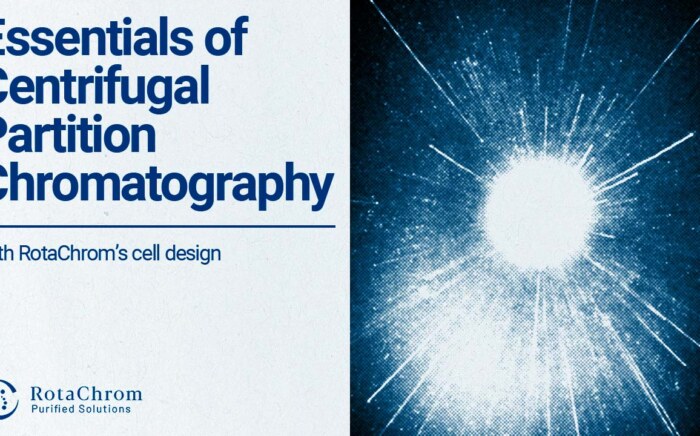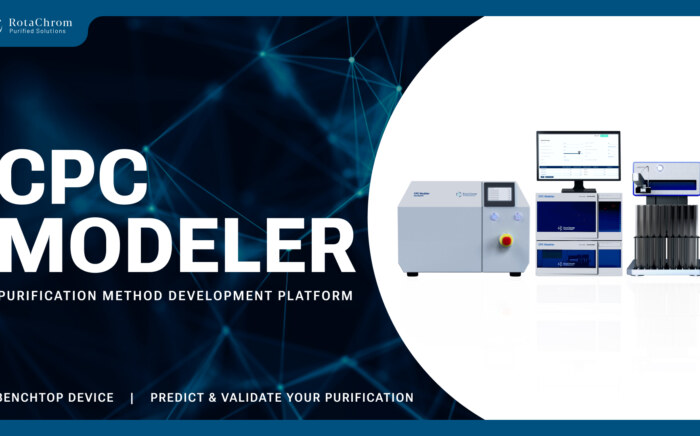Increasing separation efficiency by pH adjustment in Centrifugal Partition Chromatography
NewsSeparation, isolation, and remediation play crucial roles in chromatography, and we will delve into the reasons why in this discussion. While Centrifugal Partition Chromatography (CPC) adheres to the conventional principles of chromatography, it distinguishes itself by utilizing liquid-liquid chromatographic (LLC) techniques. In LLC, separation transpires between two immiscible liquid solvent systems acting as the stationary and mobile phases, propelled by a robust centrifugal force.
In CPC, traditional chromatographic columns are replaced with interconnected cells. These CPC cells are arranged in series, connected by ducts, and affixed to a sizeable rotor that is then filled with the liquid stationary phase. The liquid inside this array of cells is immobilized within the rotor by the formidable centrifugal force. The mobile phase, which contains the sample to be purified, constitutes the other phase of the two-phase CPC system. It is introduced into the rotor under pressure and propelled through the stationary phase in the form of minute droplets.
Chromatography serves three main purification goals: isolation, separation, and remediation, each of which presents its own complexities and challenges.
Isolation
Isolation is achieved when the objective is to focus on a specific Compound of Interest (CoI) within a complex matrix. This is a highly intricate task that requires exceptional resolving power and the ability to fractionate the CoI in a selectively targeted manner. Dealing with a single CoI amidst a matrix containing compounds with diverse physicochemical properties demands meticulous research and method optimization.
Separation
During separation, the aim is to simplify the input matrix to some extent and focus on at least two CoIs. However, this can pose a chromatographic challenge, especially in cases where the CoIs are isomers, which exhibit minimal differences to aid in their separation. Separating isomers is particularly challenging due to their similarity in physicochemical properties.
Remediation
Remediation involves the removal of unwanted or unnecessary components that may negatively impact the efficiency of the CoI. In some cases, the initial matrix may be harmful to the environment or the end user, and remediation could entail decontamination of a valuable matrix. Impurities that need to be remediated can range from health hazards and carcinogens to environmental pollutants or legally regulated compounds. Almost any type of impurity can be addressed through remediation processes.
Overall, chromatography plays a critical role in achieving the goals of isolation, separation, and remediation, and requires careful consideration of the specific challenges associated with each objective.
One Device for 3 Goals
RotaChrom’s pCPC (Preparative Centrifugal Partition Chromatography) is a cutting-edge solution that combines the iCPC device with a comprehensive solvent preparation, recovery, and regeneration system. This fully integrated production platform provides a versatile and cost-effective solution for chromatographic purification tasks, including separation, isolation, and remediation.
One of the unique features of the pCPC is its adaptability to different purification goals. As András Gáspár, RotaChrom’s Chief Product Officer, explains, “The uniqueness of the pCPC is that it can be easily optimized to do any one of the 3. It’s super versatile.” This is made possible through the “legs” of the pCPC solvent recycling system. The platform has individual legs that can be optimized for specific tasks, such as separation, isolation, or remediation, depending on the objective set for the system. In other words, the solvent recycling system can be adjusted to manage various purification goals, making the pCPC extremely flexible and powerful in its capabilities.
Unlike many other platforms, the pCPC demonstrates a high level of integration and flexibility, which sets it apart as a leading solution for preparative chromatography. With its advanced technology and innovative design, the pCPC offers a comprehensive and efficient approach to chromatographic purification, making it a valuable tool for a wide range of applications in research, production, and other industries.
Further Resources
To learn more about CPC and chromatography in general, click any of the links below.



